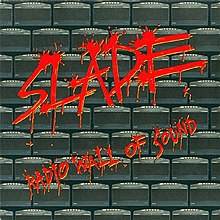
You Boyz Make Big Noize is the fourteenth and final studio album by the British rock group Slade. It was released on 27 April 1987 and reached number 98 in the UK Albums Chart. The album was largely produced by bassist Jim Lea, with two tracks produced by John Punter and another two by Roy Thomas Baker. It was the last studio album by the original lineup, prior to their split in 1992.

"Cum On Feel the Noize" is a song by the English rock band Slade, which was released in 1973 as a non-album single. It was written by lead vocalist Noddy Holder and bassist Jim Lea, and produced by Chas Chandler. It reached No. 1 in the UK Singles Chart, giving the band their fourth number one single, and remained in the charts for twelve weeks. The song was included on the band's 1973 compilation album Sladest. In a UK poll in 2015 it was voted 15th on the ITV special The Nation's Favourite 70s Number One.

"Mama Weer All Crazee Now" is a song by the British rock band Slade, released in 1972 as the lead single from their third studio album Slayed? It was written by lead vocalist Noddy Holder and bassist Jim Lea, and produced by Chas Chandler. It reached No. 1 in the UK, giving the band their third number one single, and remained in the charts for ten weeks. In the United States, the song reached No. 76.

"Coz I Luv You" is a song by the British rock band Slade, released in 1971 as a non-album single. It was written by lead vocalist Noddy Holder and bassist Jim Lea, and produced by Chas Chandler. It reached number 1 in the UK Singles Chart, giving the band their first number one single, and remained in the top 50 for fifteen weeks.

Wall of Hits is a compilation album by the British rock band Slade. It was released on 11 November 1991 and reached No. 34 in the UK Albums Chart. The album was issued by Polydor and included the last two singles to be recorded by the band: "Radio Wall of Sound" and "Universe".

Feel The Noize – Greatest Hits is a compilation album by the British rock band Slade. It was released in January 1997 and reached No. 19 in the UK charts, remaining in the charts for six weeks. The success of the compilation encouraged other bands of the Glam Rock era to release their own 'Greatest Hits' packages. At the time, a resurgence in Seventies music was happening, due to the constant mentions from Blur's Damon Albarn and Oasis's Noel Gallagher.

"Run Runaway" is a song by British rock band Slade, released in 1984 as the third single from the band's 11th studio album, The Amazing Kamikaze Syndrome, and as the lead single from the album's US counterpart, Keep Your Hands Off My Power Supply. The song was written by lead vocalist Noddy Holder and bassist Jim Lea and produced by John Punter. It reached No. 7 in the United Kingdom and was the band's first, and only, top 20 hit in the United States, where it reached No. 20.

"Take Me Bak 'Ome" is a song by the British rock band Slade, released in 1972 as a non-album single. It was written by lead vocalist Noddy Holder and bassist Jim Lea, and produced by Chas Chandler. It reached No. 1 in the UK, giving the band their second number one single, and remained in the charts for thirteen weeks. The song was certified UK Silver by BPI in 1972. In the United States, the song reached No. 97. The song would be included on the band's 1973 compilation album Sladest.

"We'll Bring the House Down" is a song by the British rock band Slade, released in 1981 as the lead single from their ninth studio album We'll Bring the House Down. It was written by lead vocalist Noddy Holder and bassist Jim Lea, and produced by Slade. The band's first single to reach the UK Top 40 since 1977, the song peaked at No. 10 in the UK, remaining in the chart for nine weeks.

"Universe" is a song by English rock band Slade, released in December 1991 as the second single from their compilation album Wall of Hits (1991). It was written and produced by bassist Jim Lea. "Universe" reached number 76 in the UK Singles Chart and was the band's last single before disbanding in 1992.
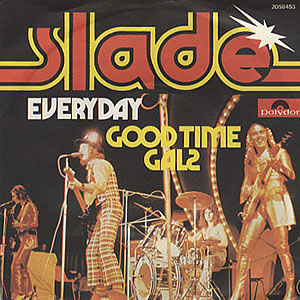
"Everyday" is a song by the British rock band Slade, released in 1974 as the second single from their fourth studio album, Old New Borrowed and Blue. It was written by lead vocalist Noddy Holder, bassist Jim Lea and his wife Louise Lea (uncredited), and was produced by Chas Chandler. It reached number 3 in the UK Singles Chart and spent seven weeks in the top 50. The single was certified UK Silver by BPI in April 1974, only three days after its release.

"Look Wot You Dun" is a song by the British rock band Slade, released in 1972 as a non-album single. The song was written by lead vocalist Noddy Holder, bassist Jim Lea and drummer Don Powell, and produced by Chas Chandler. It reached No. 4 in the UK, remaining in the charts for ten weeks. The song would be included on the band's 1973 compilation album Sladest.
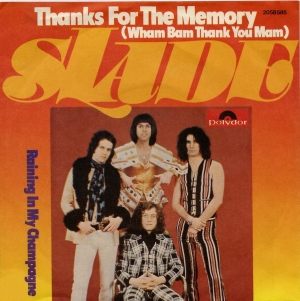
"Thanks for the Memory (Wham Bam Thank You Mam)" is a song by the British rock band Slade, released in 1975 as a non-album single. It was written by lead vocalist Noddy Holder and bassist Jim Lea, and produced by Chas Chandler. It reached No. 7 in the UK, remaining in the charts for seven weeks.
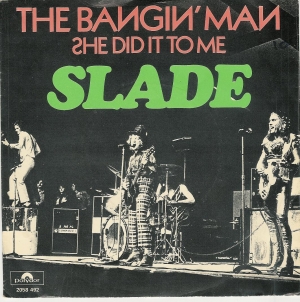
"The Bangin' Man" is a song by the British rock band Slade, released in 1974 as a non-album single. It was written by lead vocalist Noddy Holder and bassist Jim Lea, and produced by Chas Chandler. It reached No. 3 in the UK, remaining in the charts for seven weeks. The song was certified UK Silver by BPI for sales over 250,000 that same year.
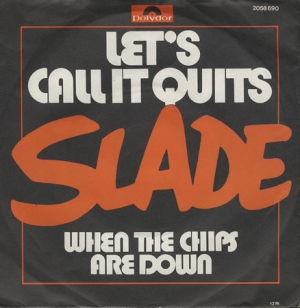
"Let's Call It Quits" is a song by the British rock band Slade, released in 1976 as the second single from their sixth studio album Nobody's Fools. The song was written by lead vocalist Noddy Holder and bassist Jim Lea, and produced by Chas Chandler. It reached No. 11 in the UK, remaining in the charts for seven weeks.
"Get Down and Get with It" is a song by American R&B singer-songwriter Bobby Marchan, first released as "Get Down with It" as the B-Side to his 1964 single "Half a Mind". In 1967, American singer Little Richard would record his own version, which was released as a single. In 1971, the British rock band Slade recorded a version of the song as "Get Down and Get with It", based on Little Richard's version, which gave the band their first UK chart hit.

"Still the Same" is a song by English rock band Slade, released in 1987 as the lead single from their fourteenth and final studio album, You Boyz Make Big Noize. The song was written by lead vocalist Noddy Holder and bassist Jim Lea, and was produced by John Punter. "Still the Same" peaked at number 73 in the UK Singles Chart and remained in the top 100 for four weeks.

"(And Now the Waltz) C'est La Vie" is a song by English rock band Slade, released in 1982 as the lead single from the band's eleventh studio album, The Amazing Kamikaze Syndrome and also included on its 1984 North American counterpart, Keep Your Hands Off My Power Supply. The song was written by lead vocalist Noddy Holder and bassist Jim Lea, and was produced by Lea. "(And Now the Waltz) C'est La Vie" reached number 50 in the UK Singles Chart and remained in the top 100 for seven weeks.
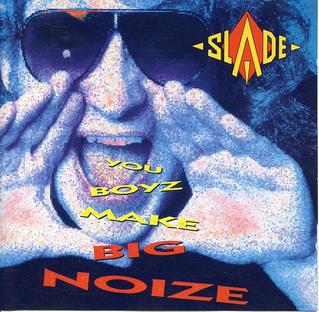
You Boyz Make Big Noize is a song by English rock band Slade, released in 1987 as a non-album single. It was written by lead vocalist Noddy Holder and bassist Jim Lea, and was produced by Lea. Named after the band's 1987 album of the same name, the song reached number 94 in the UK Singles Chart and remained in the top 100 for the one week.
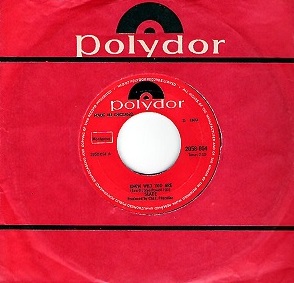
"Know Who You Are" is a song by the British rock band Slade, released in 1970 as a second and final single from their second studio album Play It Loud. The song was written by Jim Lea, Noddy Holder, Don Powell and Dave Hill, and produced by Chas Chandler. It failed to make an appearance in the UK chart.
